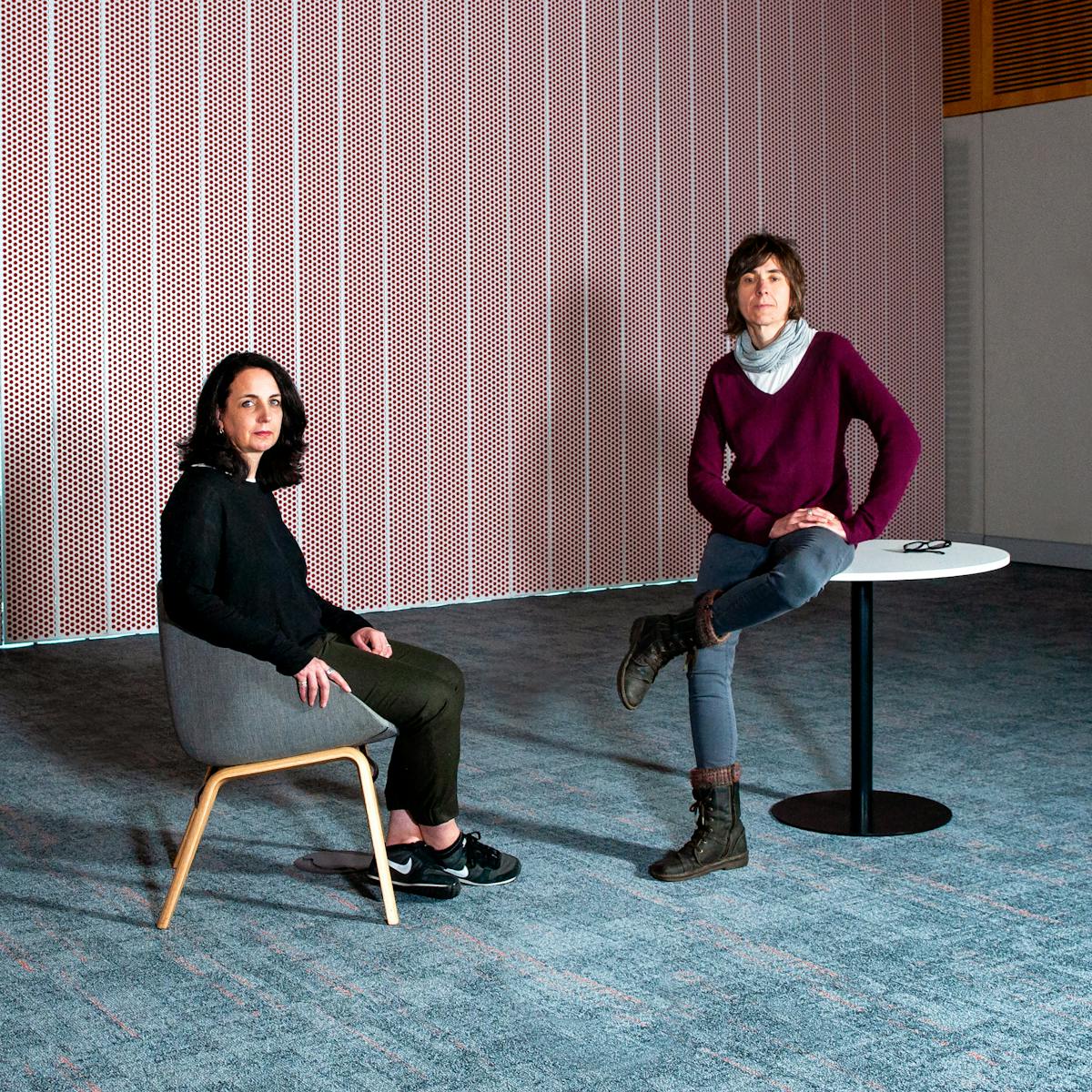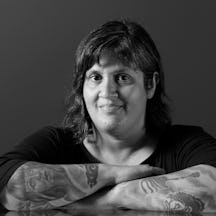To date, little has been revealed about what happened when LGBTQI people – especially women – encountered the mental health system 50 years ago. But new research is unearthing hidden, and often shocking stories.
Sarah Carr and I first met several years ago at a mental health conference when she presented a powerful account of her experiences of being a gay woman and a psychiatric survivor.
Afterwards, we spoke about a colleague’s research into gay men’s experiences of receiving aversion therapy to ‘treat’ their sexuality. For gay men, aversion therapy involved being given emetic drugs and receiving electric shocks while they viewed naked images of men. But, we asked, what happened to women? Although female homosexuality wasn’t criminalised, unlike male homosexuality, it was still classified as a mental disorder (‘sexual deviation’) that could be medically treated.
There is substantial and growing interest in LGBT history and, to a much lesser extent, psychiatric survivor history. However, there is much less known about how they overlap. While there has been a growth in ‘hidden from history’-type research (often called archival activism), there is still little knowledge about what happened to LGBTQI people, especially women, who ended up in the psychiatric system.
We knew getting funding for historical research wouldn’t be easy. We thought it would be even harder to get funding to explore psychiatric survivor experiences, let alone the experiences of lesbians, whose plight has rarely been popular or fundable. We thought it was a long shot, but we were delighted to find that we’d been awarded a modest grant and could begin work.
Our research had special resonance for Sarah. In her late teens she experienced involuntary reparative psychotherapy, involving hypnosis to try and change her sexual orientation. This was in 1990, when the World Health Organisation’s International Classification of Disease still classified homosexuality as a sexual deviation and disorder. This experience was a major motivator for her in undertaking this work:
“I wanted to understand where my experiences fitted with those of other women, especially those who may have received treatment for female homosexuality in the past. I may have been spared the electric shocks and nausea, but the fundamental idea was still the same: homosexuality is a disease of the mind.”
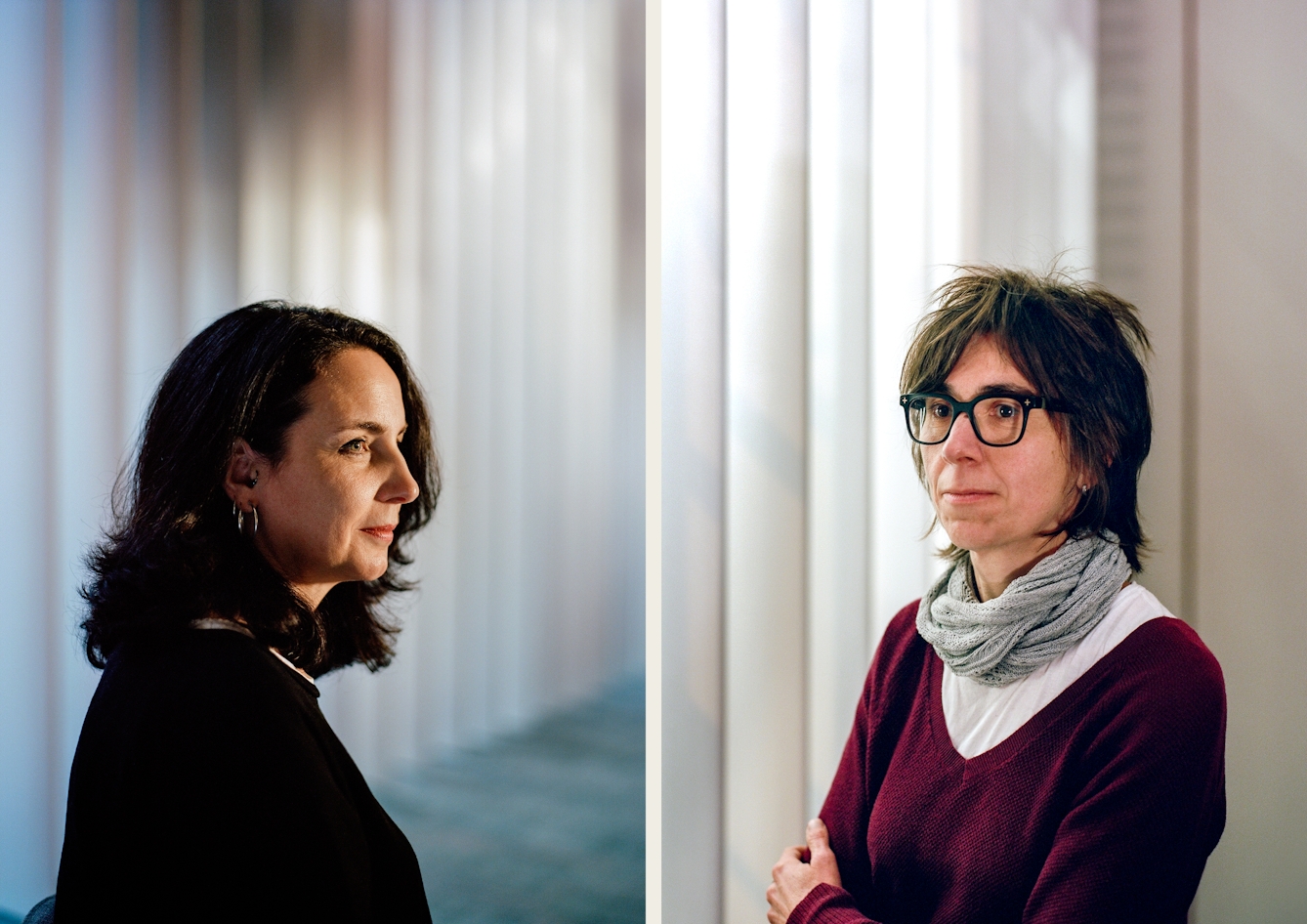
Sarah Carr and Helen Spandler.
We used mostly LGBTQI, women’s and psychiatric survivor archives. We knew it wouldn’t be easy to find accounts from women. Our colleague Tommy Dickinson, author of ‘Curing Queers’, commented that it would be like finding a “needle in a haystack”.
We relish a challenge, but this put us in a rather odd position. As researchers, we wanted to find the needles and experience the eureka moments where you find what you’re looking for. As LGBT people, we didn’t want to find examples of women being subjected to these treatments, yet at the same time we felt that we did have a duty to find them, so that they were not lost.
Treating sexual deviation in the Sixties and Seventies
We discovered raw data from a survey developed by a psychologist about the experiences of same-sex-attracted men and women who had used mental health services in England during the 1960s. We didn’t expect to find much about women, but we found about 40 responses, including some who appeared to have had various treatments for their sexuality, including aversion therapy. We felt quite emotional when we came across these. Sarah, especially, identified with the women and couldn’t help thinking it could so easily have been her:
“I almost felt like I’d uncovered ancestral graves or stumbled upon hidden lives. I got quite tearful about it. The way these surveys were buried in the archives seemed symbolic. Many of the women had handwritten some of their responses, which made them seem so human. I found this very emotionally affecting, more than I had expected to.”
As far as we know, these responses were never analysed nor written up and the questionnaire was devised in such a way that made the data difficult to interpret. So, despite our initial enthusiasm, this didn’t reveal as much as we had hoped, or feared.
In the archives of the Gay Liberation Front, we found accounts from the early 1970s targeting various psychiatric hospitals in London, specifically the Maudsley Hospital, for its use of aversion therapy to treat homosexuality. We didn’t find any direct accounts of women undergoing this treatment at the Maudsley. However, I met a lesbian scholar who had been given relevant hospital records by a sympathetic male researcher at the Maudsley.
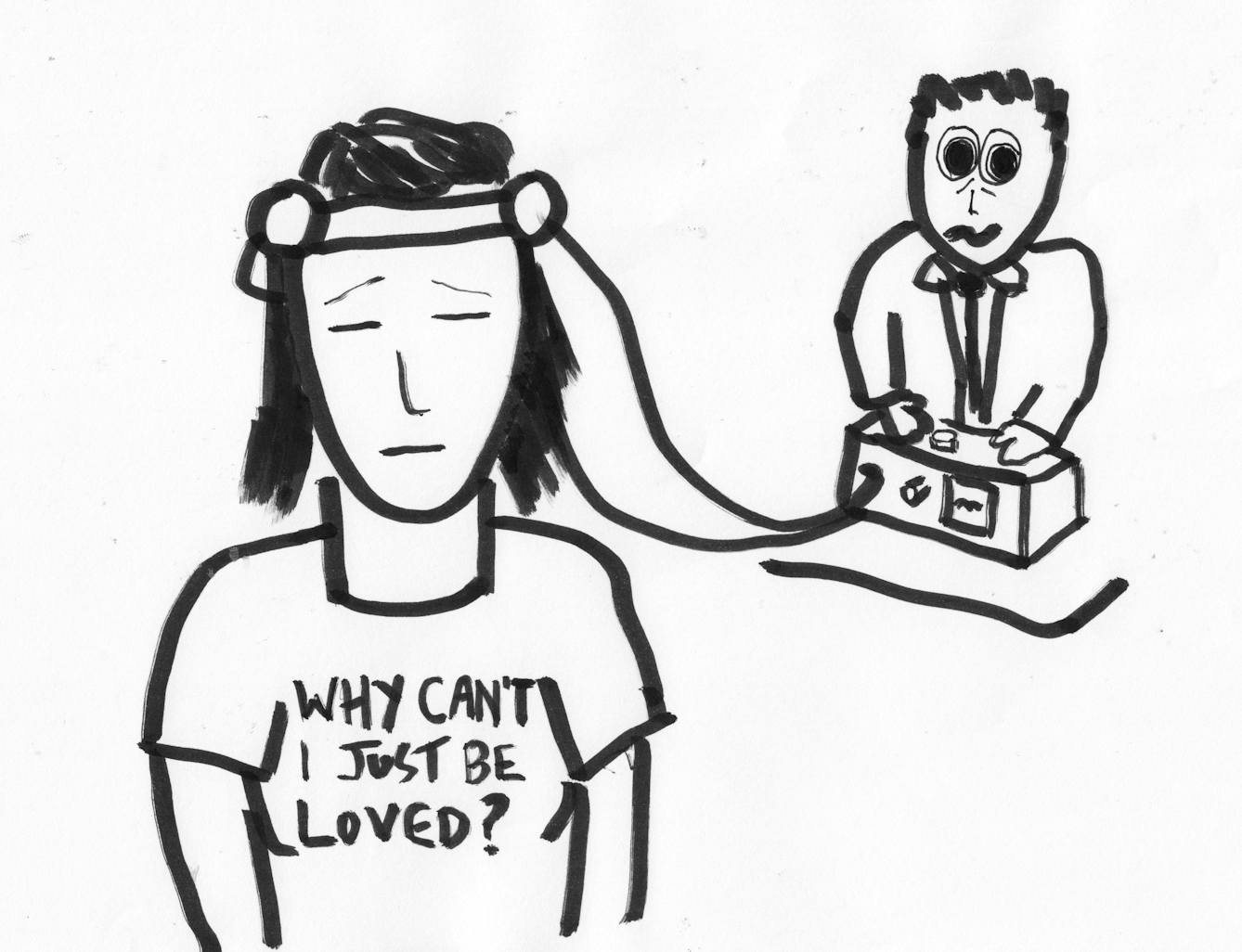
‘Why can’t I just be loved?’ Cartoon by Dolly Sen.
When we reviewed these records it clearly showed that women had been hospitalised in the 1970s at the Maudsley with ‘sexual deviation’ (i.e. homosexuality) recorded as their primary diagnosis. Therefore, given aversion therapy was used at the Maudsley on men, we couldn’t rule out the possibility that women were subjected to this too.
During the 1960s and 1970s, behaviourism was popular, and psychologists were keen to prove their new theories and test out their associated treatments. Aversion therapy was one of the flagship treatments in the behaviourist canon, and some psychologists who believed they were successfully treating male homosexuality were eager to test out their treatments on women.
We knew from the psychiatric literature that a form of aversion therapy was administered by psychologists at the North Manchester General Hospital (NMGH) in the mid-1960s. The hospital had been given an anonymous donation on the condition that the money was used to treat homosexuality.
Some women had definitely been subjected to this treatment, as two examples of young women were anonymously recorded in a research paper as ‘successfully’ treated. We were intrigued by these cases, but were unable to access NMGH records, so had no way of finding out what happened to the women involved, or how many other women went through this procedure.
Finding the needle in the haystack
By chance, I was chatting with an friend and colleague about the research and discovered that she knew a woman who’d experienced aversion therapy. When she put us in touch, it turned out that this was one of the women who had received the ‘therapy’ at North Manchester.
Now in her 70s, she was surprised to learn that her story had been written up without her permission by the psychologists as a ‘successful’ case of treatment. After the treatment, she had subsequently discovered feminism, came out, and was happily living with her long-term female partner.
Back in 1965 she had ‘voluntarily’ sought help to change her sexuality because she felt so isolated, ashamed and guilty. She recalls: “I found myself willingly sitting in a chair, looking at a blown-up picture of an unknown, semi-clad female and waiting to receive an electric shock to change my sexual preference.”
Twenty-five years later Sarah remembered being in acute suicidal distress and her male therapist deciding it was due to her sexuality: “I initially complied with his attempts to heterosexualise me because I wasn’t all that happy about my sexuality at that stage.”
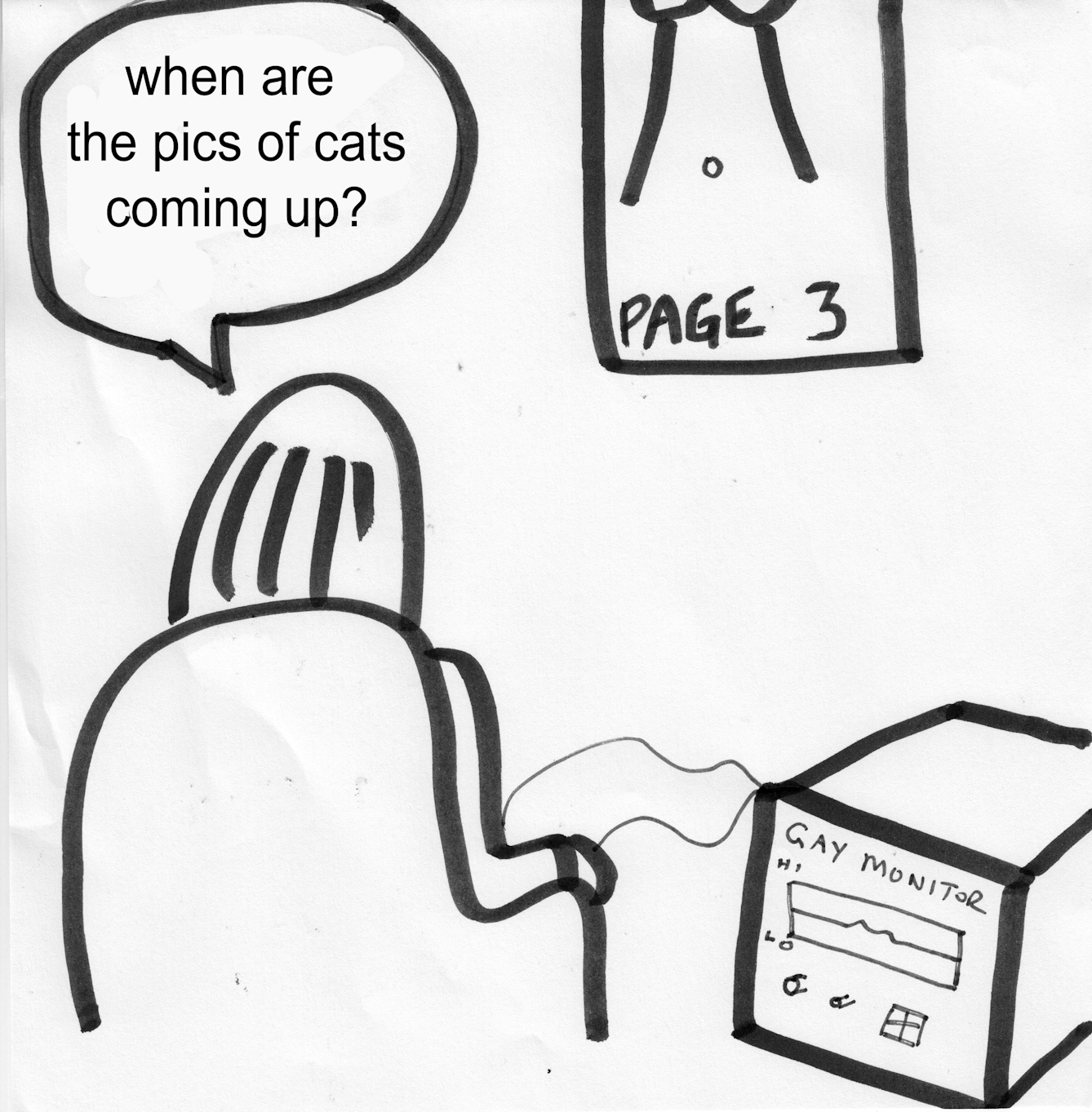
‘When are the pics of cats coming up?’ Cartoon by Dolly Sen.
Porn, voyeurism and a flawed ‘cure’
We discovered some mental health professionals not only sought to ‘cure’ lesbians but also imposed naive assumptions that women were attracted to women in the same way as they assumed straight men were. For example, while gay men were encouraged to be attracted to ‘soft porn’ images of naked women and given electric shocks when viewing pictures of naked men, women were given shocks if they lingered over sexualised images of women.
The ‘anticipatory avoidance’ type of aversion therapy, which was pioneered at North Manchester General, offered patients the option to press a button to remove the image and replace it with a sexualised image of the ‘opposite’ sex. Replacing the image with a more ‘appropriate’ one meant they avoided getting the electric shock, giving them the illusion that they were in control.
The psychologists were making all kinds of assumptions, not only about homosexuality being a ‘behavioural disorder’, but also about the nature of female sexuality. Not surprisingly, lesbian women weren’t necessarily attracted to these kinds of objectified images of women in the first place.
Similarly, Sarah recalled her psychotherapist showing her ‘top-shelf porn’ magazine images of women to see if she was ‘really’ gay or not. As she wasn’t attracted to these images, he used hypnosis to “reinforce and generalise this feeling and coax what [he assumed was] my repressed heterosexuality into returning”. She reflected on the similarly of these situations:
“In our respective treatments, we were exposed to images of women designed for male heterosexuals. This shows a weird understanding of our sexuality as being like that of straight men, which of course it isn’t. We were being tested against heteronormative ideas of sexual attraction – a significant flaw! And you really have to wonder about the motivations of some of the therapists.”
Similarly, and even more shockingly, the woman who was subjected to aversion therapy in the 1960s in North Manchester remembered the male psychologists taking an ‘unsavoury’ interest in her treatment: “I remember them sniggering about it and [the consultant psychiatrist] invited me into his office to take pictures of me semi-clothed. I have always wondered what happened to those pictures and worried whether they were used in other treatments.”
We have no way of knowing how many other women may have been subjected to these kinds of assumptions and degrading treatments. While they may be rare examples, we suspect these legacies of oppression still affect our communities today – not only the LGBTQI community, but the psychiatric survivor community too. We hope our research will make a modest contribution, not only to LGBTQI and women’s history, but to psychiatric survivor history too.
About the contributors
Helen Spandler
Helen Spandler is Professor of Mental Health Studies in the School of Social Work, Care and Community at the University of Central Lancashire. She is also Managing Editor of Asylum, the radical mental health magazine. Helen received a Seed Award from the Wellcome Trust to investigate the psychiatric treatment of lesbian, bisexual and gender non-conforming women (1952–90). An overview of the research was published in Lancet Psychiatry.
Sarah Carr
Dr Sarah Carr is a Senior Fellow in Mental Health Policy at University of Birmingham. She has experience of mental distress and mental health service use and uses this to inform all her work. Her research interests include mental health service user knowledge, mental health social care and policy, mental health and lesbian, gay and bisexual (LGB) populations and the history of psychiatry.
Jooney Woodward
Jooney Woodward is an award-winning British photographer based in London and Cornwall. Her work has been published and exhibited worldwide. In 2011 she was awarded First Prize in the Taylor Wessing Photographic Portrait Prize at the National Portrait Gallery with her portrait Harriet and Gentleman Jack.
Dolly Sen
Dolly Sen is a writer, speaker, performer, artist and filmmaker. She has been labelled ‘mad’ by a society that has helped to drive her mad. Queer, disabled, person of colour, she is a broken child taped together with glitter and stars. She/they.
